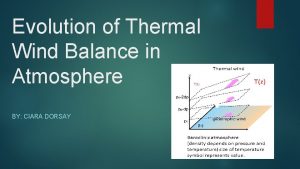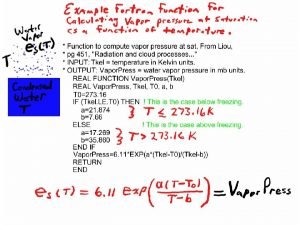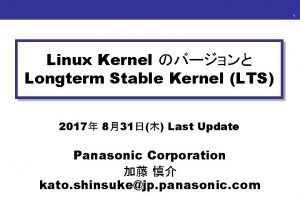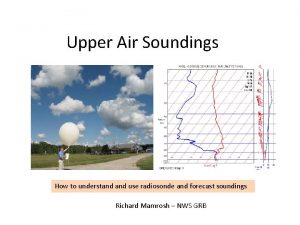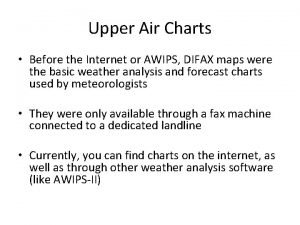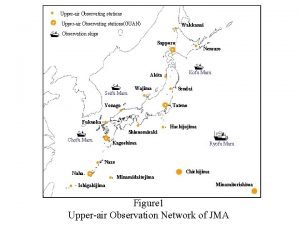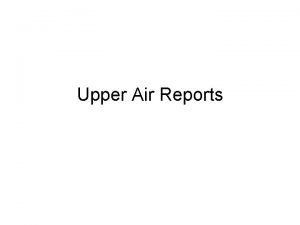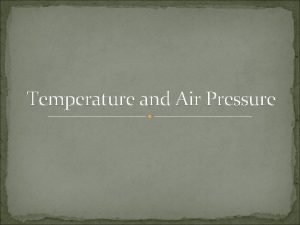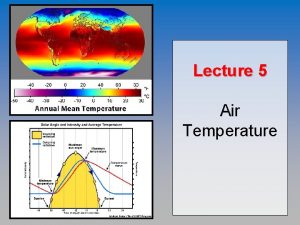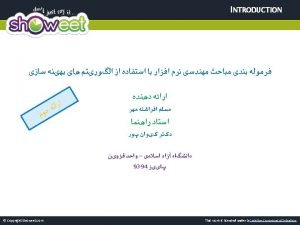LongTerm Upper Temperature Air Temperature LongTerm UpperAir Dataset







- Slides: 7

Long-Term Upper Temperature Air Temperature Long-Term Upper-Air Dataset from Satellite Microwave Sounders Presented by Cheng-Zhi Zou Center for Satellite Applications and Research (STAR) Review 09 – 11 March 2010 Image: MODIS Land Group, NASA GSFC March 2000

Requirement, Science, and Benefit Requirement/Objective • Research area: Develop an integrated global observation and data management • system for routine delivery of information, including attribution of the state of the climate Priority research activity: Producing reference data sets that provide improved climate information; using these data sets to develop integrated historical analyses of the global climate system Science • How to increase accuracy and reliability of the satellite-derived upper air temperature trend? Benefit • Enhance Society's ability in understanding global climate change – Help decision makers to frame better policies to mitigate climate change impact – Provide reference dataset for IPCC (Inter-governmental Panel on Climate Change) climate assessment – Science support for global warming debate in general public Center for Satellite Applications and Research (STAR) Review 09 – 11 March 2010 2

Challenges and Path Forward • Continuing science challenges – Instrument calibration still needs improvement – Without absolute, SI-traceable calibration, satellite mission schedule affect trend results (short overlaps, gaps) – Need improved methods to reduce diurnal-drift errors • Next steps – Compare with observations with proved long-term stability – Host workshop for community consensus • Path into applications/operations – In-house production and online distribution system • include updates for current operating satellites • trend results updated every quarter – Transition to NCDC: • provide link to STAR distribution system on NCDC website • initiate process to transition of dataset – Climate community, decision makers • provision of datasets and/or customized processing upon request by (NCDC State of the Climate, IPCC etc. ) Center for Satellite Applications and Research (STAR) Review 09 – 11 March 2010 3

Instrument and Measurement Principles Microwave Sounders on NOAA, NASA, and Met. Op-A Polar Orbiting Satellites: • MSU: 1978 -2006 • AMSU: 1998 -present • Measuring thermal emissions from atmospheric oxygen bands 50 -58 GHz: – Strength: measurement under all weather conditions except heavy precipitation (no cloud contamination); global coverage; long -term continuity; frequency stability – Weakness: calibration errors affect trend accuracy • IR Spectrometer Stratospheric Sounding Unit (SSU) : 1978 -2006 • Measuring thermal emissions from atmospheric carbon dioxide 15 - m bands – Strength: global coverage, long-term continuity – Weakness: accuracy affected by changes in atmospheric CO 2 concentration; unstable frequency response function MSU+SSU; 1978 -2006 Weighting functions for the MSU and SSU instruments, where the black curve represent the MSU weighting functions and the dashed and red curves are the SSU weighting functions for different time period, showing a shift due to an instrument CO 2 cell pressure change Center for Satellite Applications and Research (STAR) Review 09 – 11 March 2010 4

STAR’ 30 -Year MSU/AMSU Upper Air Temperature Climate Data Record • Intercalibrated 30 -year (1979 -2009) MSU/AMSU observations using simultaneous nadir overpasses • Generated consistent climate-quality, rootlevel (level-1 c) radiances for reanalysis data assimilation which accounts for artifacts such as warm target signal • Created well-merged, 28 -year gridded upper air temperature products from MSU observations for climate trend investigations • Products account for diurnal-drift errors, incident angle errors, warm target effect, and residual inter-satellite biases • Mid-tropospheric temperature warming trend much larger than previous results from University of Alabama at Huntsville Global mean temperature anomaly time series for MSU channels 2 (T 2), 3 (T 3), and 4 (T 4) onboard TIROS-N through NOAA-14. T 2, T 3, and T 4 respectively represent deep-layer temperatures of the midtroposphere, upper-troposphere, and lower stratosphere Center for Satellite Applications and Research (STAR) Review 09 – 11 March 2010 5

Intercomparison/Science Application to Prepare for Operational Implementation • Climate-quality level-1 c MSU radiances assimilated in new generation of NCEP and NASA reanalyses • Investigated global 28 -year upper air temperature trend distributions • Compared satellite time series and trends with those derived from other observing systems such as radiosonde • Compared time series and trends with satellite products derived by other groups • Investigated relationship between Arctic sea ice melting trends and temperature trends • Generating new versions using improved calibration methodologies • Products produce sound scientific results for operational implementation for climate change monitoring Center for Satellite Applications and Research (STAR) Review 09 – 11 March 2010 6

Challenges and Path Forward • Continuing science challenges – Instrument calibration still needs improvement – Without absolute, SI-traceable calibration, satellite mission schedule affect trend results (short overlaps, gaps) – Need improved methods to reduce diurnal-drift errors • Next steps – Compare with observations with proved long-term stability – Host workshop for community consensus • Path into applications/operations – In-house production and online distribution system • include updates for current operating satellites • trend results updated every quarter – Transition to NCDC: • provide link to STAR distribution system on NCDC website • initiate process to transition of dataset – Climate community, decision makers • provision of datasets and/or customized processing upon request by (NCDC State of the Climate, IPCC etc. ) Center for Satellite Applications and Research (STAR) Review 09 – 11 March 2010 7
